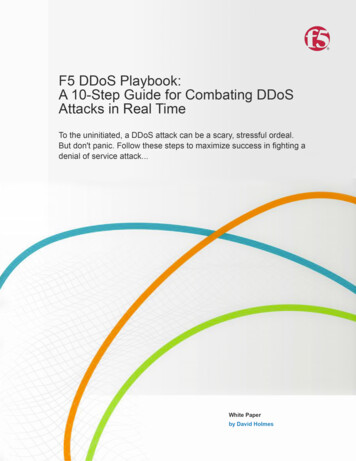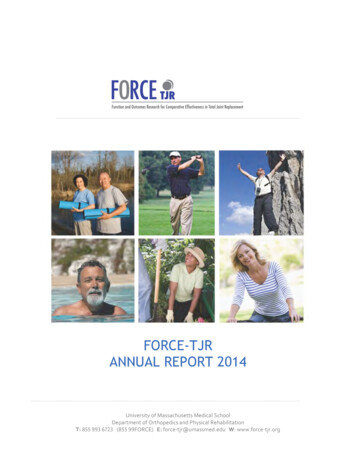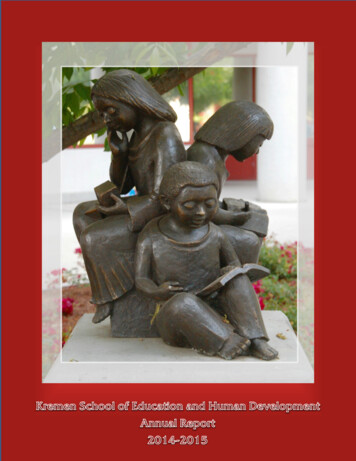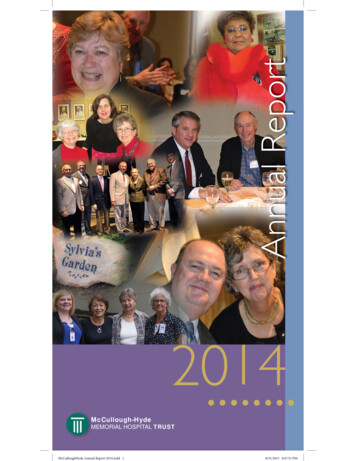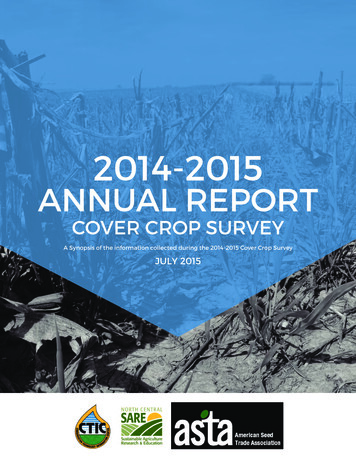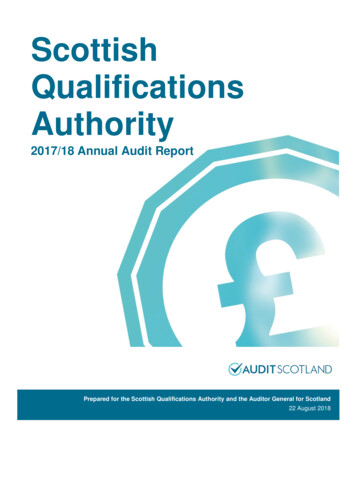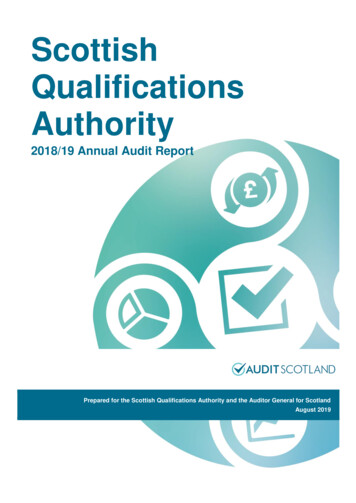
Transcription
Annual Report 2014 –15
OARnet Leadership:Pankaj ShahExecutive Director,Ohio SupercomputerCenter and OARnet(614) 292-1486pshah@oh-tech.orgChancellor John Carey directs the OhioDepartment of Higher Education andoversees the strategic initiatives of theOhio Technology Consortium and itsmember organizations in support of thestate’s technology infrastructure needs.Letha ButcherSenior Business RelationshipManager, Government & K–12(614) 292-9545lbutcher@oar.netGary GoettelOptical Engineer(614) 247-2563ggoettel@oar.net“OARnet connects millions of Ohioans,enabling them to learn, collaborate,research and celebrate in incredible ways.”— John Carey, Chancellor, Ohio Department of Higher EducationMark FullmerNetwork Architect(614) 292-8165maf@oar.netPaul SchopisChief Technology Officer(614) 292-1956pschopis@oar.netDenis WalshChief Relationship Officer(614) 292-9037dwalsh@oar.netThe Ohio Technology Consortium (OH-TECH) represents the technologyarm of the Ohio Department of Higher Education. OSC, OARnet, OhioLINK,eStudent Services and the still-in-development Research and InnovationCenter comprise a suite of technology and information member organizationsunsurpassed in any other state. Their consolidation under the OH-TECH bannerallows each organization to harness boundless synergies and efficiencies.Ann ZimmermanSenior Business RelationshipManager, Higher Education(614) 292-9022annz@oar.netoar.netConnect. Aggregate. Collaborate. Our powerful trilogy of goals provides thenecessary technology infrastructure to assure a prosperous economic futurefor Ohio and beyond. At the Ohio Academic Resources Network (OARnet),we connect our clients—found throughout education, healthcare, publicbroadcasting and government—by increasing access to affordable broadbandservice. We reduce the cost of vital technologies for our members throughaggregate purchasing. We collaborate with peers locally, within the state, acrossthe country and around the globe to spur communication and collaboration.
2014 –15HighlightsState on backboneThrough a 3.2 millionagreement, Ohio government ismoving to the OARnet backbone.More than 700 circuits have beentransitioned, and nearly 2,300end sites will be connected oncefully integrated. Layering in theconnectivity of federal entities,such as Wright-Patterson AirForce Base and NASA-GlennResearch Center, makes OARnet’s2,240-mile backbone a veryunique, stakeholder-drivenasset. The state’s investmentin OARnet shared services hasfurther reduced costs for allof OARnet’s communities.Aggregate softwarepurchasingOrganizations that purchasedVMware through OARnet’sshared service offering havesaved an estimated 4.3 million.Additionally, 38 higher educationinstitutions, including four newschools, are participating inthe 175,000 Esri Contract forArcGIS Software, used to createmaps and share intelligentvisualizations. An aggregatepurchasing agreement withSalesforce Inc. provides a 65percent discount on licenses.PRICE & PROVISIONINGper gigabit cost 6.88/Gbin FY2015K–12 upgradesApproximately 7 millionwas awarded to upgrade 29information technology centers(ITCs) and large urban districtsfrom 1 gigabit per secondbroadband speed to 10 Gbps.With upgrades completed inearly 2015, OARnet is nowseeking funding for last-mileupgrades. OARnet providesbroadband connectivity to over700 of Ohio’s K–12 schoolsthrough a partnership withITCs and large urban districts,a deal that saves them anestimated 8 million annually.Economies of scale have allowedOARnet’s Internet pricing todecrease 97 percent since 2002,while aggregated subscriptionshave increased more than 8,300percent over the same period.75 Gb/secondin FY2015total purchasedbandwidth1
OARnet ServicesOARnet delivers technology-based solutions that reduce costs, increaseproductivity and improve customer service—and has done so since itscreation in 1987. Ohio’s education, health care, public broadcasting andgovernment communities voluntarily participate in OARnet’s sharedservices programs because of the benefits and value-added servicesthey receive.AggregationSeveral OH-TECH organizationssupported Columbus’ successfulbid for 2015 IntelligentCommunity of the Year.InternetIntraOhioOARnet negotiated highlycompetitive, aggregate pricing onInternet rates for all stakeholdersin FY2016. This shared approachsecures Internet access at a pricethat would not be attainableon an individual basis. OARnetworks with multiple serviceproviders to ensure reliabilityand implements diverse routingplans to support the highestservice level.OARnet reduces the cost ofInternet services for its clients byoffering this in-state service thatconnects only to other locationsthat are linked to OARnet’snetwork. This makes dedicatedbandwidth between schoolsmore affordable by provisioningservice over existing connectionsand the in-state backbone.Internet2OARnet connects itscommunities using a circuitaggregation model. Withconsolidation hubs locatedthroughout the state, this reducesclients’ last-mile circuit costs.OARnet serves as the regionaloptical network connector forall Internet2 connections inOhio. Through a coalition ofInternet2 member schools,OARnet can provide a higherspeed connection to the nationalresearch and education networkat a cost below that availableto any single university.2Broadbandnetwork access
OARnet leadership: (left to right)Letha Butcher, Ann Zimmerman,Pankaj Shah, Paul Schopis,Mark Beadles, Kelly Sitz, MarkFullmer, (left inset) Denis Walshand (right inset) Gary GoettelTransport ServicesData CentersVirtualizationOARnet provides high-speedtransport service throughoutOhio by way of its 100 gigabitper-second backbone. Transportservice via IntraOhio connectseligible members to otherOARnet sites, resources offeredby providers such as the OhioSupercomputer Center andOhioLINK, as well as servicessuch as Voice-over-IP, businesscontinuity and high-speeddata transfers.ConnectivityVirtualization allows ITdepartments to create a virtualenvironment at the workstation,server or data-center level. Withthis technology, organizationscan buy less hardware andsoftware, reduce energy usageand require less staffingto maintain it.OARnet offers its membersaccess to more than 10geographically diverse datacenters around the state,from facilities at Wright StateUniversity and Ohio Universityto carrier-neutral data centers.Co-Location servicesOARnet collaborates with Ohiouniversities to offer co-locationservices, which include rackspace, power and access toInternet, Internet2 and IntraOhio.Members are taking advantageof these connections to expandcabinet space or implementdisaster recovery plans.VMware programOARnet, the Ohio Departmentof Higher Education and VMwareoffer a virtualization programthat enables OARnet clients topurchase virtualization softwareand maintenance at significantlyreduced prices. Through thisshared-service offering, clientshave saved an estimated 4.3 million.3
By the NumbersThrough OARnet’s flagshipshared service, the networkand its expansion into otherservices, OARnet promotescommunity and economicdevelopment by expandingaccess to affordable technology.Consider the following ROIs:SalesforceAn aggregate purchasingagreement between SalesforceInc. and the Ohio Department ofHigher Education, in conjunctionwith OARnet, the OhioDepartment of AdministrativeServices and The Ohio StateUniversity, provides a 65percent discount on Salesforcesoftware licenses. Carahsoftis managing the state contractfor these services.Identity ManagementOfferingsCurrently, 15 Ohio institutionsparticipate in eduroam, whichprovides secure, global wirelessaccess for education. Thanks to apilot project with the Universityof Rio Grande and Rio GrandeCommunity College, OARnetis working to offer a VM-basededuroam/Shibboleth serverpackage for members to use.Additionally, OARnet, Internet2and Ohio University conducteda successful pilot to determinehow to make eduroam availableas a regional offering.24/7 NOCOARnet clients have accessto outstanding engineeringsolutions through thearound-the-clock networkoperations center.4 8,000,000Partnering to co-host2015 Internet2Technology ExchangePresented by Internet2, thisannual technical event convenesthe community’s technologyvisionaries from around theU.S. and the globe. This year’sevent is hosted in Cleveland,Ohio, by Case Western ReserveUniversity in partnership withOARnet and the Ohio Internet2members, with local supportfrom OneCommunity.Combined average savingseach year on Internet costsfor OARnet’s communities. 47,000,000Amount Ohio higher education,K–12 schools and state agencieshave saved through August2014 on VMware licenses,maintenance and professionalservices. The new program withSalesforce Inc., increases thediscount for the state of Ohiofrom 5 percent to 40 percent.25%Percentage drop expected onthe cost per megabit of Internet,thanks to aggregate demandfrom the state of Ohio, Ohiohigher education and K–12 sites.The large investmentin OARnet shared servicesfrom the state has greatlyreduced costs for allOARnet communities.
CommunitiesOARnet connects Ohio’s education, health care, public broadcasting andgovernment communities through more than 2,240 miles of 100-gigabitsper-second, high-speed broadband fiber. These communities voluntarilychoose to participate in OARnet’s shared services programs because of thebenefits and value-added services they receive.LEGEND903233Higher Education Institutions &333 Higher Education RegionalBranches & SitesK–12 Education Centers(Connecting 700 School Districts)Local Government Agenices750 State of Ohio Sites52Health Care Sites &Research Institutions14Broadcast EducationMedia Stations & ServicesOARnet BackbonePoP LocationsOARnet BackboneMIDDLE MILE & LAST MILE CONNECTIONSAccess BandwidthNumber of Connections100 Gbps40 Gbps10 Gbps1 GbpsHigher Education Main Campuses3—1462K–12, ITCs & Large d Gbps Service*———38* Shared Gbps Services for Higher Ed, State & Local Governments5
Client ProfileOARnet connection improvesAir Force materials researchWHO:The Center for ElectronMicroscopy and AnalysiS(CEMAS) at The OhioState UniversityWHAT:OARnet provides a highbandwidth connectionbetween the lab andthe Air Force ResearchLab at Wright-PattersonAir Force Base.IMPACT:Air Force researchers canaccess the multimilliondollar microscopes at OhioState to improve their studyof advanced materials.6As if it isn’t amazing enoughthat the researchers at an OhioState University lab can peerinto the atomic-level workingsof structural materials andbiological systems, they arenow operating their electronmicroscopes from the nextroom and are studying howthey could leverage OARnetconnectivity to do the samework from the next university or,eventually, the next continent.The goal for the Center forElectron Microscopy andAnalysiS (CEMAS) is to “amplifywhat is possible” in thecharacterization of materialsusing multimillion-dollarelectron microscopes. Thecenter’s director envisions thelab as a hub for world-classcharacterization of materialsresearch across all disciplines,from medicine and life sciencesto engineering and physicalsciences and everythingin between.Opening on Ohio State’swest campus in 2013, the20,000-square-foot centerincludes two electronmicroscopes from the Titanline—the world’s mostpowerful, commerciallyavailable microscopes—thatare optimized to performanalysis on the atomic scale.“As we have created CEMAS tobe one of the top centers in theworld, we also have shouldered
Researchers at the Air Force Research Laboratory rely upon OARnetto provide the immense bandwidth necessary for “remote collaboration”with Ohio State’s Center for Electron Microscopy and AnalysiS (CEMAS).the responsibility to ensure thatthese capabilities are availableto researchers not only at TheOhio State University, but indeedto researchers across the entireregion, the nation and, to someextent, eventually the world,”said David McComb, Ph.D., anOhio Research Scholar andprofessor of materials scienceand engineering at Ohio State.Materials and ManufacturingDirectorate quickly recognizedthe benefit of augmenting theircapabilities by also connectingto the far more sensitiveinstruments at CEMAS.“The AFRL connection leveragesa 10-Gbps fiber-optic link tothe base between the OARnetbackbone and the DefenseResearch and Engineeringlooking at a very, very low wait,maybe only three milliseconds —that’s almost the same delayyou’ll have just inside of a facility.”McComb recognizes that, froma funding-agency perspective,university labs at every singleinstitution cannot continueto invest in instruments thatcan cost millions of dollars.The future is to place such“The people at NSF, OARnet and the Ohio Supercomputer Center, as well asourselves, recognize it’s undoubtedly going to be the way forward ”— David McComb, Ph.D., director of Center for Electron Microscopy and AnalysiS at The Ohio State UniversityThanks to OARnet’s fiber-optic,10-gigabit-per-second (Gbps)connection from the lab tothe network’s ultra-fast, 100Gbps statewide backbone, anyorganization connected toOARnet’s network can purchasetime and directly operate theinstruments from a remotelocation with no perceptible delay.CEMAS technicians installedtwo remote stations, each about60 miles from the microscopycenter: one in the Air ForceResearch Lab (AFRL) at WrightPatterson Air Force Base andanother at the University ofDayton. Earlier this year, theAir Force lab purchased a pairof electron microscopes, butscientists working there for theNetwork,” explained Dana Rogers,OARnet client representative.“With our direct connectionto OARnet, we have a shorter,simpler path to our remotestations, since we’re nottraversing a university networkor the commercial Internet,” saidDaniel Huber, a CEMAS technicalofficer, as well as a researchengineer at Ohio State’s Centerfor the Accelerated Maturationof Materials. Huber has beenworking with OARnet and theOhio Supercomputer Center toenhance remote microscopytechniques since 2006.instruments into institutionsthat have the infrastructure,the people and the support tooptimize their performancefor maximum impact.“The people at NSF, OARnet andthe Ohio Supercomputer Center,as well as ourselves, recognizethat some developmentwork and research needs tobe done in order to deliverthis,” McComb said. “But, it’sundoubtedly going to be theway forward, probably notjust for electron microscopes,but for other types of highend instrumentation.” “Utilizing OARnet, it’s just ahandful of hops—maybe threeor four hops,” he said. “So we’re7
Client ProfileThrough OARnet resources,OME-RESA keeps Appalachiandistricts well connectedWHO:Ohio Mid-Eastern RegionalEducation Service Agency,better known as OME-RESAWHAT:OARnet provides a pair oflow-cost, high-bandwidthpipelines between thisInformation TechnologyCenter and the rest of Ohio.IMPACT:OME-RESA can now offerreliable connectivity tothe 49 K–12 entities itserves, supporting suchvital activities as distancelearning and onlinestandardized testing.For many school districts inAppalachian Ohio, reliableInternet connectivity is a luxuryrather than an expectation. Withan assist from OARnet, the OhioMid-Eastern Regional EducationService Agency, better knownas OME-RESA, provides districtsin this area with high-quality,cost-effective technology andcooperative purchasing services.OME-RESA is an InformationTechnology Center (ITC) ofthe Ohio Education ComputerNetwork (OECN) that has beenin operation since 1975. OMERESA currently serves 49 entitieswith vital technology services,including server hosting,Internet connectivity, documentmanagement, fiscal and studentapplications and, most recently,support for standardized testing.OME-RESA originally connectedto the OARnet backbone ona 1-gigabit-per-second circuitaround 2006 after the completionof the Ohio K–12 Network. Sincethat time, educational contenthas experienced explosivegrowth brought on by distancelearning and virtual, rich mediacontent. As with most ITCs, OMERESA’s school districts quicklyoutgrew the 1-Gbps circuits onwhich they were originally placed.While many districts in Ohioinvested in additional bandwidthto meet demands, those inOME-RESA’s area had neitherthe funds for nor the access toadditional bandwidth. While thestate of Ohio had approved thebudget for a 10-Gbps upgrade toeach ITC, OME-RESA’s executivedirector, Angie Underwood, had“ OARnet has always been an unbelievable resource to us. The resourcesthat they provide with network redundancy, manpower and support — wewouldn’t be able to do what we do day-to-day without them.”— Adam Truex, chief technology officer, OME-RESA8
Keeping schools connected:OARnet provided a 10-Gbpsconnection for OME-RESA.to make a move sooner thanthe money could be granted.“We were going down almost ona daily basis,” Underwood said.Through OARnet, OME-RESAwas able to connect to thenetwork ring closest to Pittsburgh,providing the 10-Gbps circuit itsorely needed. Once it receivedthe middle-mile grant fundingfrom the state, OME-RESA wasable to establish a redundantconnection out of Newark, alsowith 10-Gbps bandwidth.“Because we’re in a rural area,we have to be creative withwhat we do to provide Internetto the school districts,” saidAdam Truex, OME-RESA’schief technology officer. “Wecouldn’t do it without OARnet.”The aggregate connectivity andcost-effective Internet accessthat OARnet provides are crucialto the rural areas that OMERESA serves. Each year, OARnetnegotiates aggregate pricing forits customers, so on average,Internet prices have decreasedby 15 percent annually. Whileleveraging IntraOhio bandwidthon the state backbone reducescosts for OME-RESA, its schooldistricts also benefit from thewider range of choices inInternet service providers(ISPs). In most locations, thereoften is only one ISP available,preventing competitive pricing.“Our school districts don’thave a lot of opportunity withtelecommunications providers inour area,” said Underwood. “Wecan backhaul their connectionsto us, so [OARnet] providesoptions and choice for districts.”OARnet further eases thecost-of-technology load ondistricts through its VMwarevirtualization software andmaintenance contract. OMERESA has leveraged thisresource to virtualize its entiredata center, also providinghosting to districts. Otherwise,districts would have to enterinto separate contracts andpurchase their own technology.This, as well as the connectionto the state backbone, keepsvital, personal student andstaff information secure.This is a non-negotiablerequirement for K–12 schools.“We have a lot of districts thatdo distance learning, which maycross other districts and ITCs,”Underwood said. “The statenetwork provides much morereliability and securityto administer those typesof connections.”Within the next six months, Truexsaid they will be upgrading OMERESA’s systems internally andbuilding in further redundancythrough a host site, possiblythrough another ITC. They willconnect to this site throughthe OARnet backbone.“OARnet has always been anunbelievable resource to us,”Truex said. “The resourcesthat they provide with networkredundancy, manpower andsupport—we wouldn’t beable to do what we do dayto-day without them.” 9
Client ProfileOARnet’s high-speed linksessential for virtual educationWHO:Franklin UniversityWHAT:OARnet providesconnectivity between themain campus and its 16co-locations and branchcampuses around Ohio.IMPACT:High-speed broadbandconnectivity is absolutelycritical for an institutionwhere online enrollmentcomprises approximately80 percent of the credithours for a student body ofnearly 10,000 students.10The explosive growth ofonline education in the pastdecade has drawn many adultlearners to seek out degreeprograms that offer flexibilityand constant access toresources. Franklin Universityin Columbus, Ohio, is a posterchild of this phenomenon, withonline enrollment comprisingapproximately 80 percentof its credit hours. Throw in16 co-locations and branchcampuses around the state, andit’s clear why strong networkconnections are essential to itsoperations. This is why highspeed broadband connectivitythrough OARnet’s 100-Gbpsnetwork is so critical to theuniversity’s operations.Franklin University usesOARnet as a transit networkto connect with most of itsco-locations in Ohio as wellas Urbana University, whichFranklin acquired through apartnership agreement lastyear. While Franklin enrollsmore virtual learners, Urbanaoperates under a moretraditional university setting,with mostly on-campus students.However, Urbana wanted toimprove its virtual presence.Fortunately, Urbana had existingconnectivity through OARnet.“OARnet was key in allowingus to make that happenbecause they have so muchconnectivity that we were ableto take advantage of,” said
main network node location,OARnet allows connectivityfrom Franklin to the school’score network using existinginfrastructure and services.While Franklin has dedicatednetwork connections betweenits data centers downtown andnorth of Columbus, it also hasa connection through the cityof Columbus and OARnet toprovide a redundant connectionfor network reliability.Franklin University in Columbusis known for its online programsaimed at adult learners. OARnet’shigh-speed connectivity allowsmore instructional time forstudents and professors.Richard Caldwell, manager ofnetworking, visualization andstorage at Franklin University.“We were very quickly able toget connectivity between ourcampus and the Urbana campus.”OARnet’s extensive 100 Gbpsnetwork has allowed theuniversity to create partnershipswith other organizations as well.Metro Schools in Columbus willpilot a new public STEM highschool in the fall of 2015. TheMetro Institute of Technologywill use classroom space atFranklin during the day, asmost of the university’s classesare held in the evenings.Because the existing MetroHigh School is on campus atThe Ohio State University, a“That is one more example ofwhere OARnet’s connectivity intoa lot of key locations around thestate has been a tremendousbenefit for us,” Caldwell said.Additionally, OARnet’svirtualization program withVMware allows Franklin tosaid. “We’ve also seen a bigdifference in the amount ofpower used in our data center.”At the classroom level, highspeed connectivity andaffordable software allow moreinstructional time for studentsand professors. Caldwell saidsome professors historicallyset aside a week or more atthe beginning of a semesterfor students to set up onlinelabs, for example. With thehigh bandwidth provided byOARnet, students today canjump right in to a course, withvirtual environments set up andready to go. And, Caldwell said,they look more realistic thanksto VMware’s vCloud software.Franklin University’s excellentreputation for online coursework“ It makes for a better quality educationexperience they may not have otherwise.”— Richard Caldwell, manager of networking, visualization and storageat Franklin Universitypurchase VMware softwarelicenses at discount prices.Franklin has now virtualizedover 95 percent of its servers,allowing the university to reducethe number of physical serversnecessary, lower operationaland maintenance fees and evensave money on energy costs.“There’s a tremendous amountof savings in just not having tobuy as many servers,” Caldwelland degrees fills a need for manyadult learners who would nothave the time or resources tomake it to a physical campusfor classes. The servicesprovided by OARnet make thisvirtual education experiencean even better reality.“It makes for a better qualityeducation experience theymay not have otherwise,”Caldwell said. 11
Client ProfileMorgan County NG911 makeslife-saving digital upgradeWHO:Morgan County NextGeneration 911 systemWHAT:OARnet provides reliable,redundant connectionsfor the county’sdigital first-responderdispatching system.IMPACT:As compared to itsformer system or thoseof surrounding counties,Morgan County residentsnow have a moredependable, efficient andhighly responsive 911system, which potentiallysaves more lives.Nestled in valleys along theMuskingum River, MorganCounty, Ohio’s quiet villageshave little to worry about. Thiscould be a perk of living inAppalachia, away from the bigcities. It also could be due tothe security from having thecounty’s recently implementedNext Generation 911 (NG911)system. This infrastructure,enabled by OARnet’s statewidenetwork, puts Morgan County onthe cutting-edge of emergencyresponse systems. This issomething of which MorganCounty NG911 Coordinator DavidBailey is extremely proud.“We’re not a huge county interms of population, andsometimes things trickle slowlydown here,” Bailey said.The county’s move to NG911was a near necessity. A basic,analog e911 system was installedin 2009 through the phonecompany. Unfortunately, thesystem came with its share ofissues, including being difficultto answer and slow to loadlocation maps. Bailey saidoperators would sometimesbe at or near the end of a call12before the caller’s locationwould load. Not only was thisa headache for operators, butit also delayed potentially lifesaving emergency procedures.“The 2009 e911 system becamevery cantankerous,” Bailey said.“Definitely not what you’d expectan emergency service to be.”That situation changed quickly.The e911 system providerinformed the county that it wouldend total support for the systemin 2015. County officials beganhunting for a new system andfound that NG911 was the wayto go to improve operationsand save lives. The switchmeant a change from analogto digital, meaning the countywould need to incorporatefiber-optic connections. Afterseveral meetings, Bailey foundthat they could use the OARnetbackbone to connect not justone, but two diverse paths for911 necessities. The systemwas initiated in July 2014, witha main connection linking thecounty to OARnet in Columbusand a second, redundant linklinking to the network viaLima. Previously, Morgan
“It’s time-saving, it’s life-saving. Since oursystem went live, we have had zero glitches, zerodown time and zero things we would change.”— David Bailey, Morgan County NG911 coordinatorCounty’s e911 system hadneither backup nor redundancy.The new NG911 system alsoallowed the county to solve itsmapping inconsistencies. Thenew system identifies wire line,wireless and Internet-based(VOIP) call locations as soonas they come in, allowingdispatchers to more efficientlycoordinate emergency services.“It’s time-saving, it’s life-saving.That’s what this is all about,”Bailey said. “Since our systemwent live, we have had zeroglitches, zero down time andzero things we would change.Most importantly, I have receivedzero complaints or suggestionsfrom the professionals whohandle these calls on howto improve or make thisNG911 system better.”The one downside? MorganCounty operators have to slowthe machinery down to transfercalls to surrounding countiesusing analog 911 systems.Bailey pointed out that the morecounties that adopt NG911, themore efficient existing nextgeneration operations will be.With next-generation bordercontrol mapping, Morgan Countywould not even receive wirelesscalls from out of area, and if acall did need to be transferred,the receiving location wouldreceive all digital data,including mapping.“OARnet’s high capacity andgreat reliability are essential forOhio to be able to consider stateof-the-art technology options,such as the pilot NG911 projectin Morgan County,” said StuDavis, CIO for the state of Ohio.When the county’s very first 911call system was installed, Baileywas mayor of McConnelsville,the county seat. Since then, invarious roles, he has guided thesafety of Morgan County’s 15,000residents. Looking forward, hehas been in talks with anothercounty looking to become nextgeneration compliant, also byusing the OARnet backbone.Should they do so, this countycould take over Morgan County’semergency calls, should adisastrous situation occur. In trueform, Bailey is always taking thenext step toward preparedness.“You’ve gotta look down theroad and say ‘What’s thebest proven practice and bestpath to Next Gen 911?’” 13
OSC & OARnet Advisory arnetoar.netlinkedin.com/company/oarnetThomas Beck, Ph.D.Professor, Universityof CincinnatiJudy Opalek, Ph.D.Director, Academic ResearchServices, OhioHealthDave BenderExecutive Director ofInformation & TechnologyServices, Otterbein UniversityRick PennyDirector, AdministrativeTechnologies, LakelandCommunity CollegeDonald BretlAssociate Director of Research& Development, P&GPankaj ShahExecutive Director,Ohio SupercomputerCenter & OARnetJohn CareyChancellor, Ohio Departmentof Higher EducationStuart DavisChief InformationOfficer, State of OhioDuane DetwilerManager & Chief Engineer,Vehicle StructuresReliability Department,Honda R&D AmericasGwen EvansExecutive Director, OhioLINKTed GriffithManaging Director ofInformation Technology& Logistics, JobsOhioLynn TrinkoAssistant Deputy Chancellor, OhioDepartment of Higher EducationChancellor’s DesigneePeter VoderbergAssistant Director of Policy,Ohio Gov. John KasichCaroline Whitacre, Ph.D.Vice President for Research,The Ohio State UniversityBill WilsonChief Information Officer,Cleveland State University1224 Kinnear Road Columbus, OH 43212 ph: (614) 485-6722
Mark Fullmer Network Architect (614) 292-8165 maf@oar.net Paul Schopis Chief Technology Officer (614) 292-1956 pschopis@oar.net Denis Walsh Chief Relationship Officer (614) 292-9037 dwalsh@oar.net Ann Zimmerman Senior Business Relationship Manager, Higher Education (614) 292-9022


